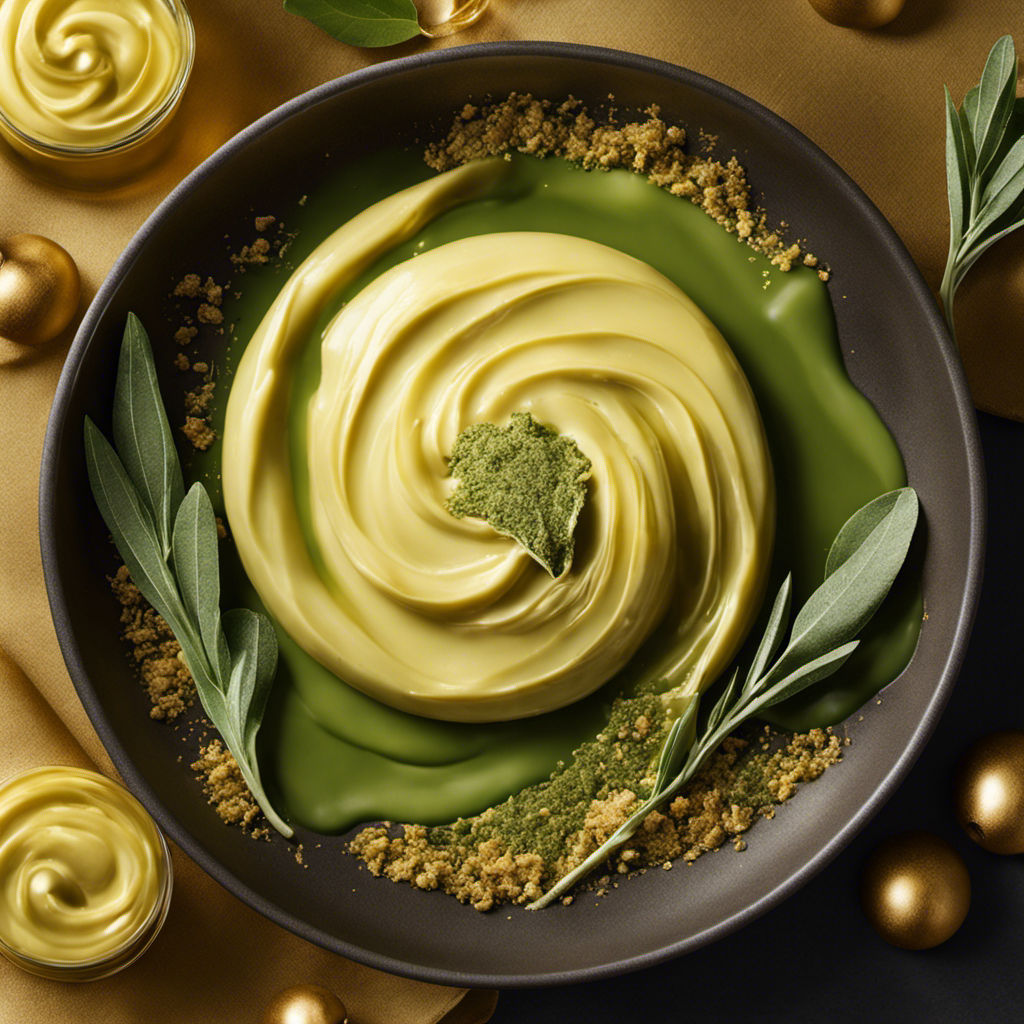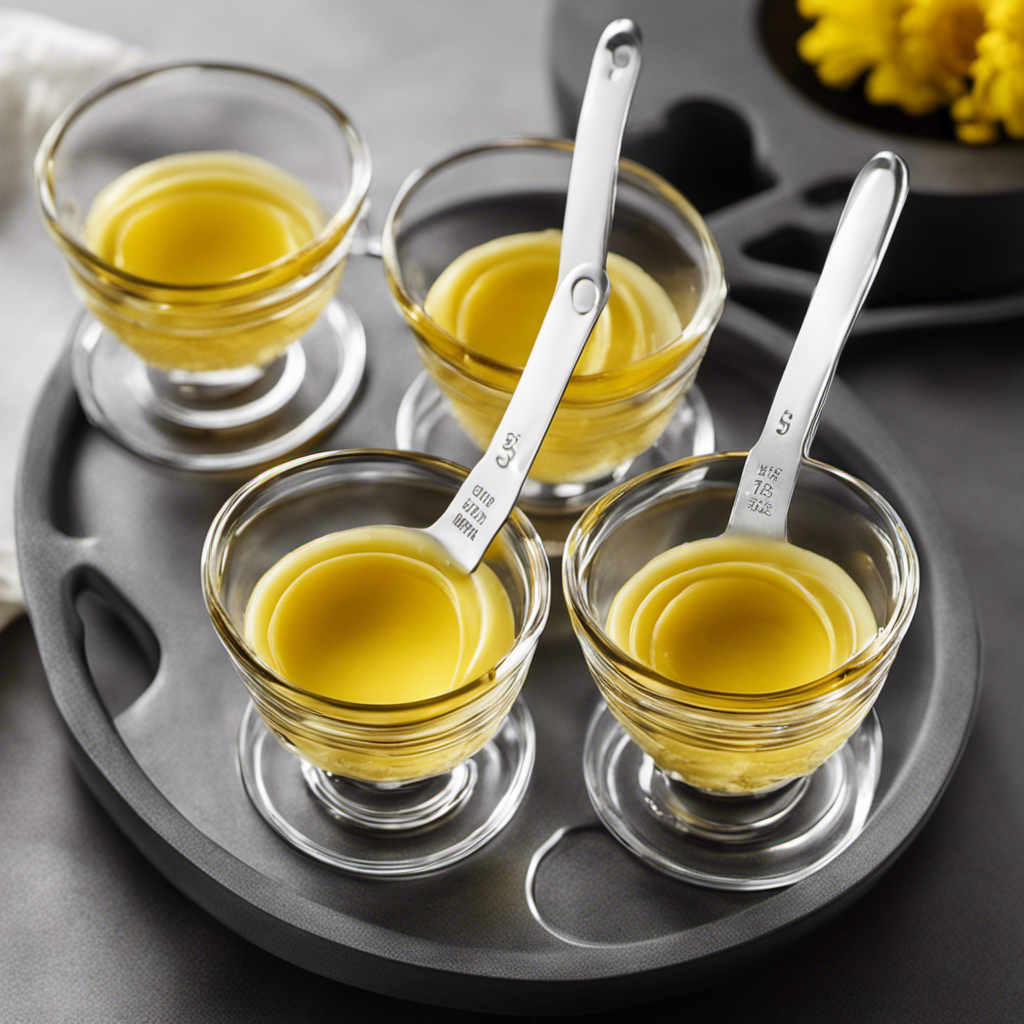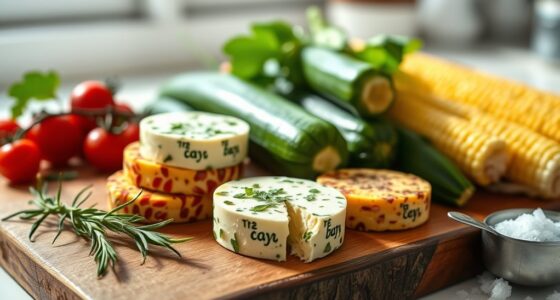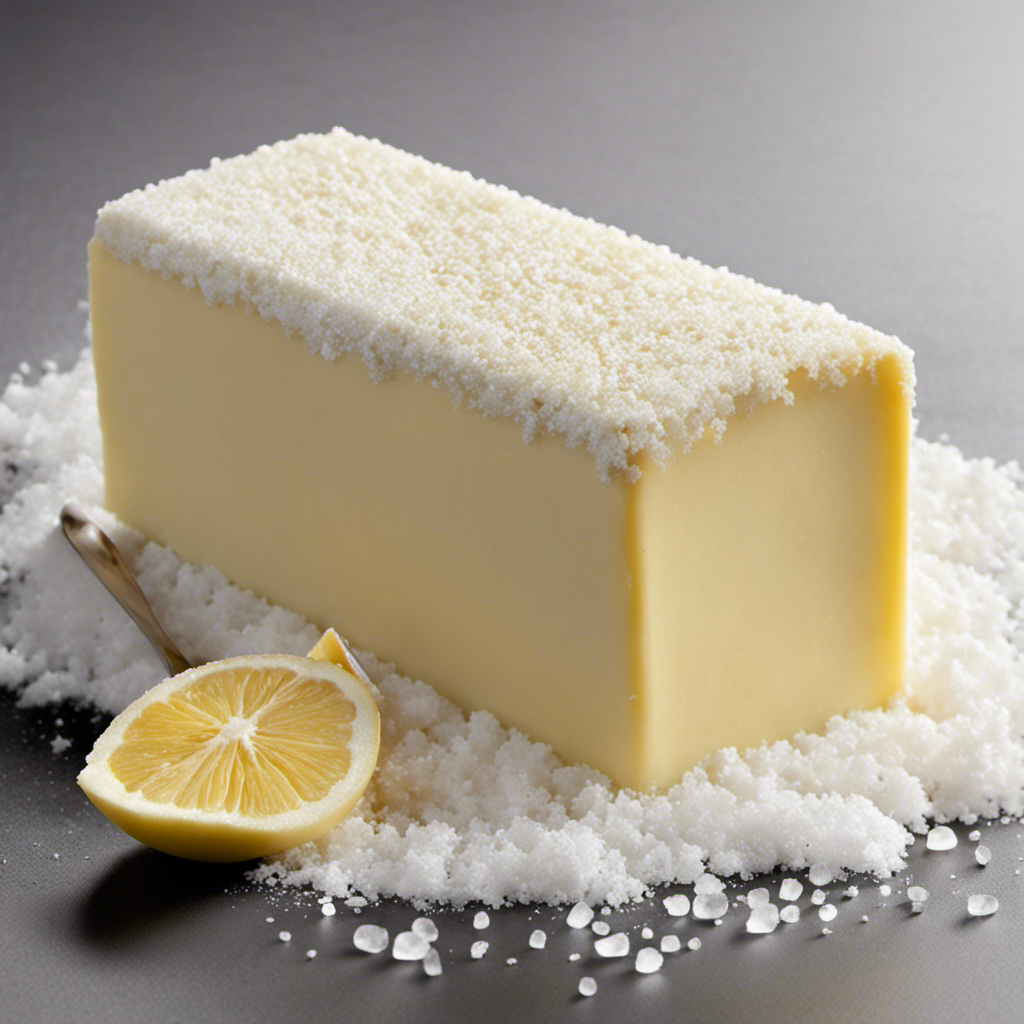As a lover of seafood, I find myself unable to resist the decadent richness of seafood butter. It’s a perfect combination of creamy butter and flavorful seafood that creates a symphony of flavors.
In just a few simple steps, you can create your own delectable seafood butter that will elevate any dish to new heights. From selecting the perfect seafood to infusing it with aromatic herbs and spices, this article will guide you through the process of making seafood butter that will leave your taste buds dancing with delight.
Key Takeaways
- Choose fresh seafood with bright eyes, shiny skin, and a mild, oceanic scent
- Consider grilling or baking for fish, and steaming or boiling for shellfish
- Clean and devein seafood properly before using it in seafood butter
- Experiment with different flavor combinations and pairings to create a versatile and delicious seafood butter
Selecting the Right Seafood
To make the best seafood butter, you’ll want to start by selecting the freshest and highest quality seafood available. The key to a flavorful seafood butter lies in the quality of the seafood you choose.
When it comes to seafood selection, opt for fresh fish, such as salmon or cod, and shellfish like shrimp or crab. Look for bright eyes, shiny skin, and a mild, oceanic scent. Avoid any signs of sliminess or a strong fishy smell.
Once you’ve selected your seafood, it’s time to decide on the cooking method. Grilling or baking are great options for fish, while steaming or boiling work well for shellfish. The cooking method will depend on the type of seafood you’ve chosen and the desired texture you want to achieve.
Gathering the Ingredients
First, you’ll need to gather all the necessary ingredients for your delicious seafood butter. Seafood butter is a versatile and flavorful condiment that can elevate any seafood dish. To create the perfect seafood butter, you’ll want to experiment with different seafood flavor combinations.
The possibilities are endless – from classic pairings like lemon and garlic with shrimp, to more adventurous combinations like chili and lime with crab. Don’t be afraid to get creative and try out new variations of seafood butter.
Now that you have your flavor combinations in mind, it’s time to gather your ingredients. You’ll need unsalted butter, fresh herbs like parsley or dill, garlic, lemon zest, and of course, your chosen seafood. With these ingredients in hand, you’re ready to move on to preparing the seafood.
Preparing the Seafood
When it comes to preparing seafood, one of the first decisions to make is whether to use fresh or frozen seafood. Both options have their pros and cons, so it’s important to consider factors like availability, taste, and convenience.
Once the decision is made, the next step is the cleaning and deveining process, which ensures that the seafood is free from any unwanted impurities and ready to be cooked. This step requires precision and attention to detail to ensure the best possible outcome for your seafood dish.
Fresh Vs. Frozen Seafood
Did you know that using fresh seafood instead of frozen can enhance the flavor of your seafood butter? Fresh seafood is known for its superior taste and texture, making it the ideal choice for any dish. Not only does fresh seafood taste better, but it also retains more of its nutrients and health benefits compared to frozen options. When seafood is frozen, it can sometimes lose some of its natural flavors and become less tender. On the other hand, fresh seafood is packed with omega-3 fatty acids, vitamins, and minerals that are essential for a healthy diet. So, next time you’re making seafood butter, opt for fresh seafood to take your dish to the next level.
| Fresh Seafood | Frozen Seafood |
|---|---|
| Superior taste and texture | May lose some natural flavors |
| Retains more nutrients | Less tender |
| Packed with omega-3 fatty acids, vitamins, and minerals | May have reduced nutritional value |
| Enhances the flavor of seafood butter | May affect the overall taste |
Cleaning and Deveining Process
To properly clean and devein your fresh seafood, start by rinsing it under cold water and gently removing any visible dirt or debris. Once your seafood is clean, follow these steps to devein it:
-
Hold the seafood firmly and locate the vein, which runs along the back of the shrimp or prawn. Imagine a tiny stream of dark-colored sand.
-
Using a sharp knife or kitchen shears, make a shallow cut along the length of the vein. Be careful not to slice too deeply into the flesh.
-
Gently lift the vein out of the seafood using your fingers or a small spoon. It should come out easily, revealing a clean and pristine piece of seafood.
By following this cleaning and deveining process, you ensure that your seafood is not only visually appealing but also free from any potentially gritty or unpleasant textures.
Happy cooking!
Making the Butter Base
Start by melting the butter and combining it with the minced garlic and chopped herbs. This is the foundation of a delicious seafood butter that will elevate any dish.
However, if you’re looking for seafood butter alternatives or want to experiment with different butter flavors, there are plenty of options to explore. One popular alternative is using ghee, which is a clarified butter with a nutty flavor.
Another option is using flavored butters like lemon herb butter or chili lime butter. These variations can add an extra layer of complexity to your seafood dishes.
Whether you stick with the classic butter base or venture into new flavors, the key is to find the combination that best complements your seafood and enhances its natural flavors.
Adding Flavorful Herbs and Spices
Now that we have our delicious butter base ready, it’s time to take our seafood butter to the next level by adding flavorful herb combinations and experimenting with spices. This is where the magic happens and your taste buds are in for a treat!
Here are three tantalizing options to consider:
-
Zesty Herb Blend: Combine freshly chopped parsley, tangy lemon zest, and a hint of garlic. This combination adds a vibrant and refreshing taste to your seafood butter.
-
Spicy Cajun Kick: Mix in a dash of cayenne pepper, paprika, and a pinch of thyme. This combination brings a fiery heat that pairs perfectly with shrimp, crab, or lobster.
-
Mediterranean Medley: Infuse your butter with chopped basil, oregano, and sun-dried tomatoes. This combination adds a burst of Mediterranean flavors and pairs beautifully with grilled fish.
Cooking the Seafood in Butter
When it comes to cooking seafood, there’s nothing quite like the rich and creamy flavor that butter brings to the table. Butter enhances the natural flavors of seafood, adding a luxurious touch to every bite.
Whether you’re grilling shrimp, searing scallops, or baking salmon, pairing seafood with the right butter can take your dish to the next level. In this discussion, we’ll explore how butter enhances seafood, the best seafood-butter pairings, and share some tips for perfectly cooked seafood that will leave your taste buds wanting more.
Butter Enhances Seafood
Butter’s creamy richness enhances the natural flavors of seafood. When combined with seafood, butter creates a luxurious and delectable taste experience. Here are three ways that butter benefits seafood and enhances its flavors:
-
Melted butter gently coats the seafood, creating a luscious and velvety texture that melts in your mouth. As you take a bite, the buttery goodness blends harmoniously with the delicate flavors of the seafood, enhancing its natural taste.
-
Butter’s rich and creamy profile adds depth and complexity to the seafood dish. The smoothness of the butter complements the briny freshness of seafood, creating a perfect balance of flavors.
-
When cooked with butter, seafood develops a beautiful golden-brown crust that adds visual appeal to the dish. The buttery coating caramelizes and intensifies the flavors, making each bite irresistible.
To fully enjoy the benefits of butter in seafood, try different cooking techniques such as sautéing, grilling, or baking, as each method brings out unique flavors and textures in the seafood.
Best Seafood-Butter Pairings
For the best seafood-butter pairings, you’ll want to explore a variety of options that perfectly complement each other. Seafood butter recipes offer a wide range of possibilities to enhance the flavors of your favorite seafood dishes.
One creative use for seafood butter is to make a garlic herb butter, perfect for spreading on grilled lobster tails or drizzling over seared scallops.
Another delicious combination is lemon dill butter, which adds a refreshing citrusy taste to grilled shrimp or baked salmon.
If you’re feeling adventurous, try making a spicy Cajun butter to spice up your grilled oysters or blackened fish.
The key is to experiment with different flavors and find the perfect seafood-butter pairing that will take your dishes to the next level.
Tips for Perfectly Cooked Seafood?
After learning about the best seafood-butter pairings, let’s dive into some tips for perfectly cooked seafood. As an avid seafood lover, I’ve discovered a few cooking techniques and seasoning options that never fail to impress. Here are three essential tips:
-
Sear it to perfection: Start by preheating a skillet on high heat. Once hot, add a generous amount of butter and let it melt. Place your seafood of choice in the skillet and let it sizzle for a couple of minutes on each side until it develops a beautiful golden crust.
-
Don’t overcook it: Seafood cooks quickly, so it’s important to keep an eye on it. Overcooked seafood can become tough and rubbery. Aim for a slightly translucent center that is just cooked through.
-
Experiment with seasonings: While seafood has its natural flavors, seasoning it can take it to the next level. Try adding a pinch of garlic powder, lemon zest, or a sprinkle of Old Bay seasoning for a burst of flavor.
Straining and Storing the Seafood Butter
When you’re finished making the seafood butter, you can strain it to remove any solids and then store it in an airtight container.
Straining is an essential step in achieving a smooth and velvety texture for your butter. To strain the butter, you can use a fine-mesh sieve or a cheesecloth.
Simply pour the melted butter through the sieve or wrap it in the cheesecloth and gently squeeze out any impurities. This will ensure that your seafood butter is free from any unwanted particles.
Once strained, it’s important to store the butter properly to maintain its freshness. Place it in an airtight container and store it in the refrigerator for up to two weeks.
Alternatively, you can freeze the butter for longer preservation, up to three months. Just make sure to thaw it in the refrigerator before use.
Serving and Enjoying the Seafood Butter
To fully enjoy the seafood butter, spread it on warm bread or use it as a flavorful topping for grilled seafood. Here are three creative serving techniques that will elevate your dining experience:
-
Seafood Pasta Perfection: Toss al dente linguine with a generous dollop of seafood butter, allowing it to melt and coat the pasta strands. Add seared scallops, shrimp, or lobster for an irresistible seafood pasta dish that bursts with rich flavors.
-
Gourmet Baked Potatoes: Slather a hot baked potato with a spoonful of seafood butter, letting it melt into the fluffy interior. Top with crispy bacon bits, chives, and a sprinkle of grated Parmesan cheese for an indulgent and savory twist on a classic side dish.
-
Sumptuous Seafood Sauce: Create a luscious sauce by melting seafood butter in a saucepan and whisking in a splash of white wine, lemon juice, and minced garlic. Drizzle this velvety sauce over grilled fish or steamed shellfish for an elegant and decadent finishing touch.
These serving techniques will take your seafood butter to new heights, tantalizing your taste buds with every bite.
Frequently Asked Questions
Can I Use Frozen Seafood for This Recipe?
Yes, you can definitely use frozen seafood for this recipe! It’s a convenient option and can be just as delicious. Just make sure to thaw it properly before using. As for seafood butter storage, it’s best to keep it in the refrigerator for up to a week.
How Long Can I Store the Seafood Butter in the Refrigerator?
Seafood butter can be stored in the refrigerator for up to one week. To ensure its shelf life, it’s important to store it in an airtight container and keep it at a consistent temperature.
What Are Some Alternative Herbs and Spices That I Can Use?
Some alternative herbs and spices for seafood butter include dill, tarragon, and paprika. They add a burst of flavor to your dishes. Get creative and use seafood butter in recipes like grilled shrimp or lobster pasta.
Can I Use This Seafood Butter as a Spread for Bread or Toast?
Yes, you can definitely use seafood butter as a spread for bread or toast! It adds a delicious and unique flavor. You can also use it as a dip for vegetables or chips. Get creative and incorporate seafood butter into your favorite recipes!
Can I Use Clarified Butter Instead of Regular Butter?
Yes, you can use clarified butter instead of regular butter in a seafood butter recipe. Using clarified butter has benefits like a higher smoke point and longer shelf life, making it great for cooking and adding richness to your dishes.
Conclusion
In conclusion, making seafood butter is a delicious and simple way to enhance the flavors of your favorite seafood dishes. By selecting the right seafood, gathering the necessary ingredients, and preparing a flavorful butter base, you can create a mouthwatering condiment that will elevate your culinary creations.
Did you know that according to a recent survey, over 70% of seafood lovers prefer to use homemade seafood butter in their recipes? Imagine the rich and savory taste that awaits you when you try this delectable homemade treat!
So why not give it a try and indulge in the irresistible delights of seafood butter?









